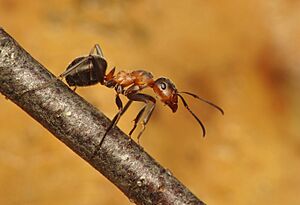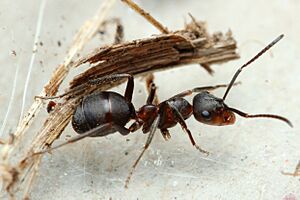Black-backed meadow ant facts for kids
Quick facts for kids Black-backed meadow ant |
|
|---|---|
 |
|
| Formica pratensis, a worker ant | |
 |
|
| Formica pratensis, a queen ant (top view) | |
| Conservation status | |
| Scientific classification | |
| Synonyms | |
|
Formica pratensis, also called the black-backed meadow ant, is a type of red wood ant. These ants are part of the Formicidae family. They are known for their reddish bodies and dark backs. You can find them in many parts of Europe and Asia.
Contents
About the Black-Backed Meadow Ant
What Do They Look Like?
Formica pratensis worker ants can grow to be about 4.5 to 9.5 millimeters long. This makes them a bit bigger than other common wood ants. Queen ants are even larger, reaching about 9.5 to 11.3 millimeters.
Their bodies are mostly reddish. However, their bellies and the top of their heads are black or dark brown. This makes them look darker than many other wood ant species. Their whole bodies are covered with tiny hairs. They also have two big, dark patches on their upper body parts. Their legs, antennae, and mouthparts are usually reddish or dark brown.
How Do They Live?
These ants build their nests from things like grasses, pine needles, and straw. Their nests can grow quite large, sometimes up to a meter (about 3 feet) across. Each nest usually has only one queen ant, or sometimes just a few.
Winged male and female ants can be seen in the nests from late April to September. This is because this ant species has two main groups of young ants each year. The first group grows from late April to mid-July. The second group develops from mid-August to late September. These ants mainly eat insects and other small creatures. They also collect sweet honeydew from tiny insects called aphids.
Where Do They Live?
You can find Formica pratensis in many countries across Europe. These include Austria, Belgium, Bulgaria, Czech Republic, Estonia, Finland, France, Georgia, Germany, Hungary, Italy, Latvia, Lithuania, Luxembourg, Moldova, Netherlands, Norway, Poland, Romania, Russia, Serbia and Montenegro, Slovakia, Spain, Sweden, Switzerland, Turkey, and the Ukraine. They also live in parts of eastern Asia and the Middle East.
Sadly, this species has disappeared from the UK since 1988. In some forests in central Europe, these red wood ants are becoming rare. This might be due to things like pollution and acid rain. When ant populations decline, it can upset the balance of nature in the ecosystem.
What Kind of Places Do They Like?
Formica pratensis ants prefer rough, open areas like mountain pastures. They can live at heights up to about 1,500 meters (nearly 5,000 feet). You can also find them in dry, open fields, meadows, and along roadsides.



